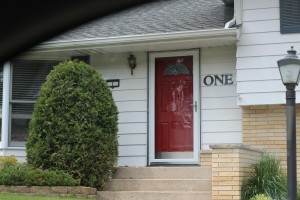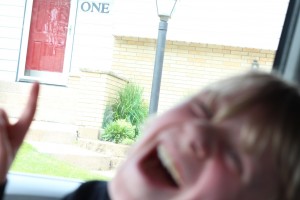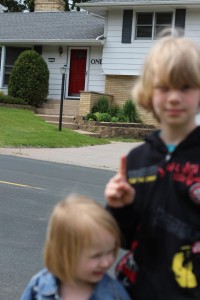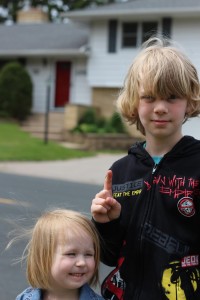When Owen was three years old, he began noticing that every building had a number on it. Especially while driving around in the car, he asked Jennifer and me what the numbers meant. He asked what the number on our apartment building was.
We explained that houses had unique numbers on them to help people find the house, like the mailman or other visitors.
Sometimes he commented on interesting numbers. When he saw a house with five digits on it, he found that very noteworthy. He also felt compelled to point out house number 1111 and house number 321.
It was inevitable that, eventually, he asked, “Where’s house number one?”
“Well,” I said, “I’m not exactly sure.”
He was under the impression that, somewhere in the word, there was a house numbered ‘1’, and all the other house numbers radiated out from there.
I explained that it doesn’t work that way. “They can’t do it that way, because then when new houses are built, we wouldn’t have a number to give them. Like, if there’s a house number 2 and a house number 3, and every other number up to 10 million is taken up, then when a new house is built in between house 2 and 3…what would we call it?”
This then led to an explanation of odd and even numbered houses being on opposite sides of the street, and how house numbers radiated out from a central point in a city. I told him I used to live at a house numbered 14750, because it was about 14.7 miles south of Minneapolis, and it was an even number because we were on the east side of the street. Later, I lived at 6705: even though it was just as far south from Minneapolis as the other house, it had a much lower number because it was on a north/south street, and were we 6.7 miles east of Minneapolis.
Then, of course, Owen caught my mistake when he found very low numbered homes that were quite far from either downtown, and I had to then clarify that some cities grew up at the same time as Minneapolis and St. Paul and, therefore, started their own numbering systems instead of going in tandem with the metropolises. Such cities included Hastings, Stillwater, Shakopee, and South St. Paul.
But he still wanted to know where house number one was. Jennifer and I finally figured out that the numbers radiate out north/south from Summit Avenue in St. Paul. As we drove up and down streets like Snelling, Lexington, and Hamline, we pointed out to Owen that the house numbers were getting smaller and smaller. “Look Owen,” we’d say excitedly, “There’s house 23! There house 21! There’s 16!” Owen watched, enraptured in the descending numbers…and then it would stop.
“Where’s house number one?” he’d ask again, slightly disappointed.
“Well, technically, the numbers probably radiate out from the middle of Summit Avenue, so I suppose there is no number one, since there’s no house literally on Summit Avenue. So even a house planted directly on the corner of Summit and a cross street has a number of at least…6. And 6 was the lowest we found, though we were careful to point out any other time we spotted a house with a number lower than 10, regardless of which city were we in. Still, we never found Owen’s dream home. We never found #1.
Years passed and then, one day in May, I drove down to the city of West St. Paul to rent a tool from the local Menards. As always during the summer, road construction meant I couldn’t take the best route. I ended up snaking through some residential areas, trying to find the back road that led to Menards.
“These house numbers are really low,” Owen said. “Look! There’s number 11!”
“Oh, yeah, look at that!” I said, mirroring his excitement. “And there’s 7! And there’s 3! Could it be…?” I said, slowing down. “Woa! Look! There’s number one!”
“Yay!” Owen shouted. “We finally found it! Are we close to Summit?” he asked. “No,” I said, then realized that, of course, West St. Paul is another of those old cities that has its own numbering system.
We continued on our way to rent the tool I needed that day, but several hours later, Owen and Isla accompanied me to return the tool and, this time, we stopped to celebrate the completion of long-time search; the Oneness of Owen’s goal.




